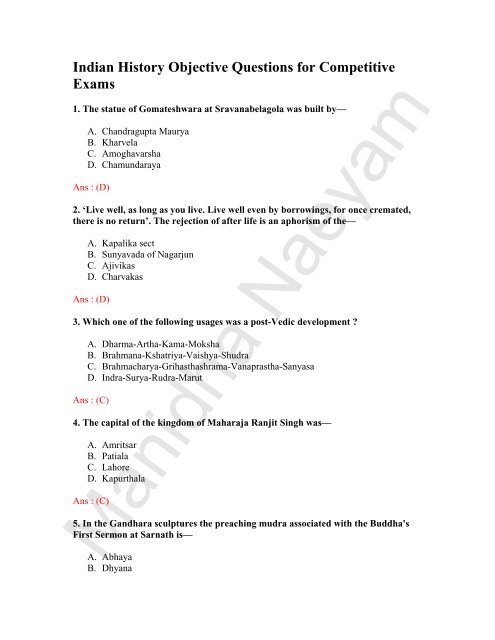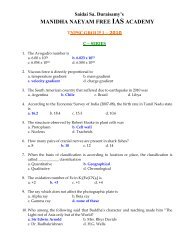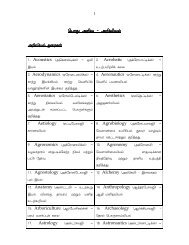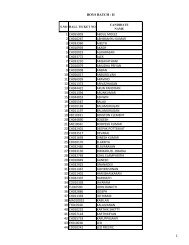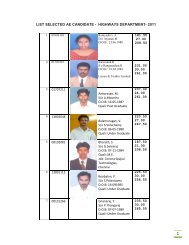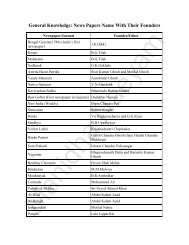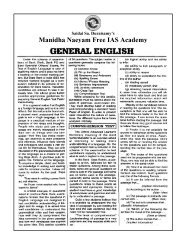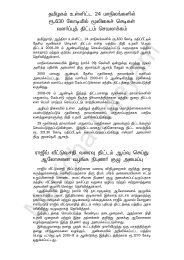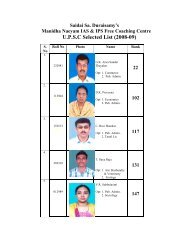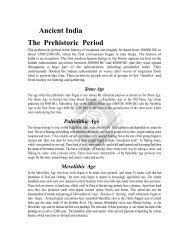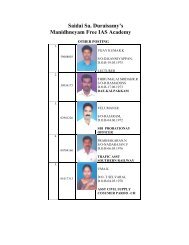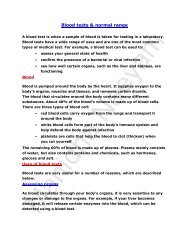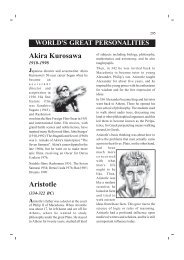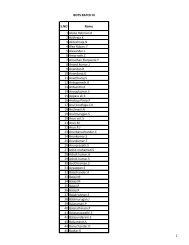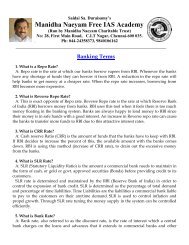Indian History Objective Questions for Competitive Exams - saidai ...
Indian History Objective Questions for Competitive Exams - saidai ...
Indian History Objective Questions for Competitive Exams - saidai ...
You also want an ePaper? Increase the reach of your titles
YUMPU automatically turns print PDFs into web optimized ePapers that Google loves.
<strong>Indian</strong> <strong>History</strong> <strong>Objective</strong> <strong>Questions</strong> <strong>for</strong> <strong>Competitive</strong><br />
<strong>Exams</strong><br />
1. The statue of Gomateshwara at Sravanabelagola was built by—<br />
A. Chandragupta Maurya<br />
B. Kharvela<br />
C. Amoghavarsha<br />
D. Chamundaraya<br />
Ans : (D)<br />
2. ‘Live well, as long as you live. Live well even by borrowings, <strong>for</strong> once cremated,<br />
there is no return’. The rejection of after life is an aphorism of the—<br />
A. Kapalika sect<br />
B. Sunyavada of Nagarjun<br />
C. Ajivikas<br />
D. Charvakas<br />
Ans : (D)<br />
3. Which one of the following usages was a post-Vedic development ?<br />
A. Dharma-Artha-Kama-Moksha<br />
B. Brahmana-Kshatriya-Vaishya-Shudra<br />
C. Brahmacharya-Grihasthashrama-Vanaprastha-Sanyasa<br />
D. Indra-Surya-Rudra-Marut<br />
Ans : (C)<br />
4. The capital of the kingdom of Maharaja Ranjit Singh was—<br />
A. Amritsar<br />
B. Patiala<br />
C. Lahore<br />
D. Kapurthala<br />
Ans : (C)<br />
5. In the Gandhara sculptures the preaching mudra associated with the Buddha's<br />
First Sermon at Sarnath is—<br />
A. Abhaya<br />
B. Dhyana<br />
Manidha Naeyam
C. Dharmachakra<br />
D. Bhumisparsa<br />
Ans : (C)<br />
6. The name of the poet Kalidas is mentioned in the—<br />
A. Allahabad pillar inscription<br />
B. Aihole inscription<br />
C. Alapadu grant<br />
D. Hanumakonda inscription<br />
Ans : (B)<br />
7. Zero was invented by—<br />
A. Aryabhatta<br />
B. Varahamihira<br />
C. Bhaskara I<br />
D. An unknown <strong>Indian</strong><br />
Ans : (D)<br />
8. Which one of the following important trade centres of ancient India was on the<br />
trade route connecting Kalyana with Vengi ?<br />
A. Tagara<br />
B. Sripura<br />
C. Tripuri<br />
D. Tamralipti<br />
Ans : (A)<br />
9. The first <strong>Indian</strong> ruler who joined the subsidiary Alliance was—<br />
A. The Nawab of Oudh<br />
B. The Nizam of Hyderabad<br />
C. Peshwa Baji Rao II<br />
D. The king of Travancore<br />
Ans : (B)<br />
Manidha Naeyam<br />
10. Vidhushaka, a common character in Sanskrit drama is invariably a—<br />
A. Brahmana<br />
B. Kshatriya
C. Vaishya<br />
D. Shudra<br />
Ans : (A)<br />
11. Toramana belonged to the ethnic horde of the—<br />
A. Scythians<br />
B. Hunas<br />
C. Yue-chis<br />
D. Sakas<br />
Ans : (B)<br />
12. Who among the following is said to have witnessed the reigns of eight Delhi<br />
Sultans ?<br />
A. Ziauddin Barani<br />
B. Shams-i-siraj Afif<br />
C. Minhaj-us-siraj<br />
D. Amir Khusrau<br />
Ans : (D)<br />
13. The first <strong>Indian</strong> ruler to organize Haj pilgrimage at the expense of the state<br />
was—<br />
A. Alauddin Khilji<br />
B. Feroz Tughlaq<br />
C. Akbar<br />
D. Aurangzeb<br />
Ans : (C)<br />
14. Who among the following ladies wrote a historical account during the Mughal<br />
period ?<br />
A. Gulbadan Begum<br />
B. Noorjahan Begum<br />
C. Jahanara Begum<br />
D. Zebun-nissah Begum<br />
Ans : (A)<br />
Manidha Naeyam<br />
15. The first to start a joint stock company to trade with India were the—
A. Portuguese<br />
B. Dutch<br />
C. French<br />
D. Danish<br />
Ans : (B)<br />
16. The caves and rock-cut temples at Ellora are—<br />
A. Buddhist<br />
B. Buddhist and Jain<br />
C. Hindu and Jain<br />
D. Hindu, Buddhist and Jain<br />
Ans : (D)<br />
17. The significance of the Bengal Regulation of 1793 lies in the fact that—<br />
A. It provided <strong>for</strong> the establishment of the Supreme court<br />
B. It restricted the application of English law to Englishmen only<br />
C. It accommodated the personal laws of Hindus and Muslims<br />
D. It provided <strong>for</strong> the appointment of the <strong>Indian</strong> Law Commission<br />
Ans : (C)<br />
18. The Mansabdari system introduced by Akbar was borrowed from the system<br />
followed in—<br />
A. Afghanistan<br />
B. Turkey<br />
C. Mongolia<br />
D. Persia<br />
Ans : (C)<br />
19. Which one of the following monuments has a dome which is said to be one of the<br />
largest in the world ?<br />
A. Tomb of Sher Shah, Sasaram<br />
B. Jama Masjid, Delhi<br />
C. Tomb of Ghiyas-ud-din Tuglaq, Delhi<br />
D. Gol Gumbaz, Bijapur<br />
Ans : (D)<br />
Manidha Naeyam<br />
20. Ashtapradhan was a Council of Ministers—
A. In the Gupta administration<br />
B. In the Chola administration<br />
C. In the Vijaynagar administration<br />
D. In the Maratha administration<br />
Ans : (D)<br />
21. The concept of Anuvrata was advocated by—<br />
A. Mahayana Buddhism<br />
B. Hinayana Buddhism<br />
C. Jainism<br />
D. The Lokayata School<br />
Ans : (C)<br />
22. Which one of the following territories was not affected by the revolt of 1857 ?<br />
A. Jhansi<br />
B. Jagdishpur<br />
C. Lucknow<br />
D. Chittor<br />
Ans : (D)<br />
23. Which one of the following pairs is correctly matched ?<br />
A. Battle of Buxar— Mir Jafar Vs Clive<br />
B. Battle of Wandiwash—French Vs East India Company<br />
C. Battle of Chelianwala—Dalhousie Vs Marathas<br />
D. Battle of Kharda—Nizam Vs East India Company<br />
Ans : (B)<br />
24. The word ‘Hindu’ as reference to the people of Hind (India) was first used by—<br />
A. The Greeks<br />
B. The Romans<br />
C. The Chinese<br />
D. The Arabs<br />
Ans : (A)<br />
Manidha Naeyam<br />
25. Hughly was used as a base <strong>for</strong> piracy in the Bay of Bengal by—<br />
A. The Portuguese
B. The French<br />
C. The Danish<br />
D. The British<br />
Ans : (A)<br />
<strong>Indian</strong> <strong>History</strong> <strong>Questions</strong> <strong>for</strong> <strong>Competitive</strong> <strong>Exams</strong><br />
1. The term ‘nishka’ which meant an ornament in the Vedic period was used in later<br />
times to denote a/an—<br />
A. Weapon<br />
B. Agricultural implement<br />
C. Script<br />
D. Coin<br />
Ans : (D)<br />
2. Which one of the following pairs of kings of ancient and medieval periods of<br />
<strong>Indian</strong> history and the works authored by them is correctly matched ?<br />
A. Krishnadevaraya : Samaranganasutradhra<br />
B. Mehendravarman : Mattavilasaprahasana<br />
C. Bhojadeva : Manasollasa<br />
D. Somesvara : Amuktamalyada<br />
Ans : (B)<br />
3. The founder of Boy Scouts and Girl Guides movement was—<br />
A. Charles Andrews<br />
B. Robert Montgomery<br />
C. Richard Temple<br />
D. Baden Powell<br />
Ans : (D)<br />
4. Which one of the following pairs is not correctly matched ?<br />
Manidha Naeyam<br />
A. Dharamsastra : Works on religion and philosophy<br />
B. Chaturvarnya : Four Ashrams<br />
C. Shudra : Service to three varnas<br />
D. Mahamatra : Superior Officials
Ans : (B)<br />
5. Chanakya was known as—<br />
A. Bhattasvamin<br />
B. Rajasekhara<br />
C. Vishnugupta<br />
D. Visakhadatta<br />
Ans : (C)<br />
6. A lot of details regarding the village administration under the Cholas is provided<br />
by the inscriptions at—<br />
A. Thanjavur<br />
B. Uraiyur<br />
C. Kanchipuram<br />
D. Uttaramerur<br />
Ans : (D)<br />
7. In Jainism ‘perfect knowledge’ is referred to as—<br />
A. Jina<br />
B. Ratna<br />
C. Kaivalya<br />
D. Nirvanas<br />
Ans : (C)<br />
8. Who among the following is NOT associated with medicine in ancient India ?<br />
A. Dhanvantri<br />
B. Bhaskaracharya<br />
C. Charaka<br />
D. Susruta<br />
Ans : (B)<br />
9. In Mughal paintings one notices the adoption of the principles of <strong>for</strong>eshortening<br />
whereby near and distant people and things could be placed in perspective. This was<br />
due to the influence of the—<br />
Manidha Naeyam<br />
A. British<br />
B. Dutch<br />
C. Portuguese
D. Danish<br />
Ans : (C)<br />
10. Ashokan inscriptions were first deciphered by—<br />
A. Buhler<br />
B. Robert Sewell<br />
C. James Prinsep<br />
D. Codrington<br />
Ans : (C)<br />
11. Among the four works mentioned below which one is encyclopaedic in nature ?<br />
A. Amarakosa<br />
B. Siddhantasiromani<br />
C. Brhat Samhita<br />
D. Ashtangahrdaya<br />
Ans : (A)<br />
12. Consider the following passage—<br />
In the course of a career on the road spanning almost thirty years, he crossed the breadth<br />
of the Eastern hemisphere, visited territories equivalent to about 44 modern countries and<br />
put behind him a total distance of approximately 73000 miles.<br />
The world's greatest traveller of pre-modern times to whom the above passage refers is—<br />
A. Megasthenes<br />
B. Fa Hien<br />
C. Marco Polo<br />
D. Ibn Battuta<br />
Ans : (C)<br />
13. The first political organisation established in India in 1838 was known as—<br />
A. British India Society<br />
B. Bengal British India Society<br />
C. Settlers Association<br />
D. Zamindary Association<br />
Ans : (D)<br />
Manidha Naeyam<br />
14. The foundation of modern education system in India was laid by—
A. The Charter Act of 1813<br />
B. Macaulay's Minutes of 1835<br />
C. The Hunter Commission of 1882<br />
D. Wood's Despatch of 1854<br />
Ans : (B)<br />
15. Uplift of the backward classes was the main programme of the—<br />
A. Prarthana Samaj<br />
B. Satya Shodhak Samaj<br />
C. Arya Samaj<br />
D. Ramakrishna Mission<br />
Ans : (B)<br />
16. The Ryotwari settlement was introduced by the British in the—<br />
A. Bengal Presidency<br />
B. Madras Presidency<br />
C. Bombay Presidency<br />
D. Madras and Bombay Presidencies<br />
Ans : (D)<br />
17. The Buddhist Sect Mahayana <strong>for</strong>mally came into existence during the reign of—<br />
A. Ajatashatru<br />
B. Ashoka<br />
C. Dharmapala<br />
D. Kanishka<br />
Ans : (D)<br />
18. The last in succession of Jaina Tirthankaras was—<br />
A. Parsvanatha<br />
B. Rishabha<br />
C. Mahavira<br />
D. Manisubrata<br />
Ans : (C)<br />
Manidha Naeyam<br />
19. The earliest rock cut caves in western India are those at—<br />
A. Nasik, Ellora and Ajanta
B. Junnar, Kalyan and Pitalkhora<br />
C. Ajanta, Bhaja and Kondane<br />
D. Bhaja, Pitalkhora and Kondane<br />
Ans : (A)<br />
20. The name by which Ashoka is generally referred to in his inscriptions is—<br />
A. Chakravarti<br />
B. Dharmadeva<br />
C. Dharmakirti<br />
D. Priyadarsi<br />
Ans : (D)<br />
21. Which one of the following is a monument constructed by Sher Shah ?<br />
A. Kila-i-Kuhna mosque at Delhi<br />
B. Atala Masjid at Jaunpur<br />
C. Barasona Masjid at Gaur<br />
D. Quiwwat-al-Islam mosque at Delhi<br />
Ans : (A)<br />
22. Which among the following cities is considered as one of the oldest surviving<br />
cities in the world ?<br />
A. Mathura<br />
B. Varanasi<br />
C. Hardwar<br />
D. Ayodhya<br />
Ans : (A)<br />
23. The earliest evidence of silver in India is found in the—<br />
A. Harappan culture<br />
B. Chalcolithic cultures of Western India<br />
C. Vedic texts<br />
D. Silver punch marked coins<br />
Ans : (A)<br />
Manidha Naeyam<br />
24. Which one of the following is a language of Baluchistan but linguistically<br />
Dravidian ?
A. Brahui<br />
B. Kui<br />
C. Parji<br />
D. Pengo<br />
Ans : (A)<br />
25. Which one of the following is the most fundamental difference between<br />
Mahayana Buddhism and Hinayana Buddhism ?<br />
A. Emphasis on ahimsa<br />
B. Casteless society<br />
C. Worship of gods and goddesses<br />
D. Worship of stupa<br />
Ans : (C)<br />
Manidha Naeyam


